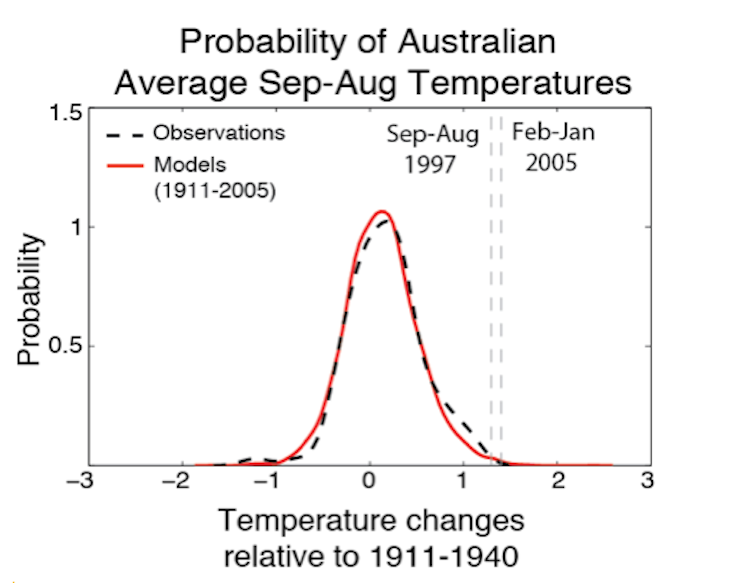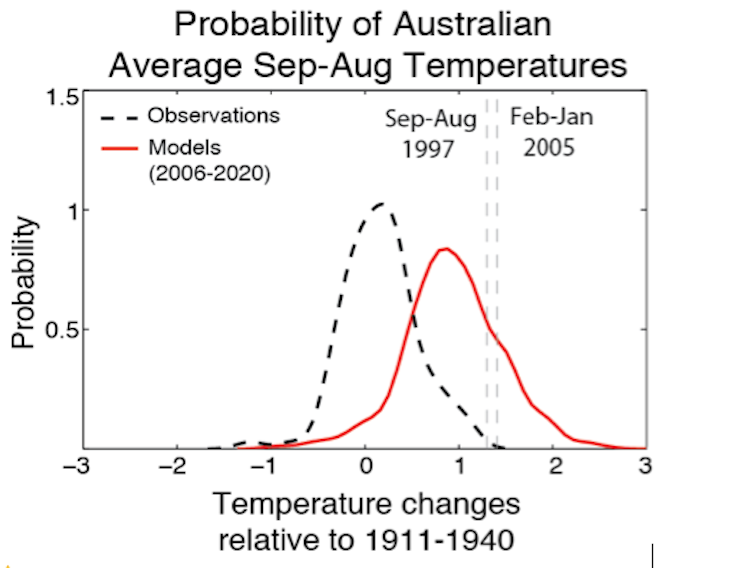It’s official, the past 12 months have been the hottest in Australia for more than a hundred years. Temperatures averaged across Australia between September 2012 and August 2013 were hotter than any year since good records began in 1910. The previous record was held by the 12-month period from February 2005 to January 2006.
The new record follows a suite of broken records following last year’s “angry summer”, including the hottest summer since records began.
New weather records are being set all the time. Sometimes these are record cold temperatures, but more often in recent times these have been record hot temperatures. A common question is what is the human role, if any, in these records compared with natural variations of weather and climate?
The link between global warming and human causes has been firmly established over the last two decades. Multiple studies have shown that it is very unlikely that natural variations in climate can explain recent global climate change. While these results are clear, it is still helpful to determine the influence of global warming on regional climate extremes, since such extremes are often more influenced by natural variability.
However, attributing a single event or a record to human activities isn’t easy. But last year Hurricane Sandy put the spotlight on climate change and extreme weather.
And in late June this year, our scientific study published in the journal Geophysical Research Letters showed human-caused climate change substantially increased the likelihood of the very hot 2013 Australian summer. Human influences on the climate system increased the chances of our record hot summer by more than five times.
Using the same approach, we have now analysed the past 12-month’s temperatures across Australia. Our results show that human influences on the climate very likely increased by more than one hundred times the chances of the record 12-month Australia temperature.
We started our analysis by considering more than 20 of the latest generation of climate models. These models all participated in an international initiative that undertakes standardised climate model experiments. From these we selected the nine models that best captured the observed variability in Australian average temperature to perform our analyses.
Using these remaining nine state-of-the-art global climate models, we investigated the chances of setting a new record high 12-month average temperature across Australia. The previous record was set in 2005.
We compared temperature probabilities from a suite of model simulations of the climate including only natural climate influences (volcanoes and solar radiation changes) with a parallel set of model simulations including natural and human influences on the climate, such as increasing greenhouse gases.
The results were clear. When human influences were included in the model simulations, the probability of setting a new record, as occurred at the end of August 2013, was dramatically higher. Indeed, it was very likely (with 90% confidence) that human influences increased the odds by at least 100 times of setting a new record 12-month temperature.


When we considered the repeated model simulations with just natural climate factors, we found only one 12-month period out of more than 5700 years that exceeded the record set in 2005. However, when we considered the model simulations including human influences on the climate, as well as natural variability, for the period 2006 to 2020, we found 41 12-month periods out of 465 years exceeded the record.
Hence, it would be nearly impossible to get such a new Australian temperature record due to natural climate variations alone. However, such records become quite common, about once every eleven years in our current climate, with increased global average temperatures due to human activity.
The recent record temperature is also notable because it occurred at a time when El Niño-Southern Oscillation (ENSO) conditions were neutral (neither El Niño nor La Niña occurring), which typically produces normal, rather than warm, temperatures across Australia.
The model experiments also show that these types of extreme Australian temperatures will become more severe and more frequent in the future, with further global warming.

